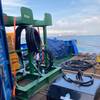Waterfront Protection against Global Warming
Rising sea levels and changes in water chemistry in New York Harbor and beyond should trigger a comprehensive planning effort to protect waterfront development from the threat of potential inundation, according to Malcolm G. McLaren of McLaren Engineering Group.
“People know about global warming but very little discussion has centered on how to plan for it,” said McLaren, founder, president and CEO of the West Nyack, N.Y.-based firm. “If sea levels continue to rise at their current rate, large stretches of shoreline development will be jeopardized. That’s why we need to rethink existing models and anticipate possible scenarios brought on by climate change.”
Due in part to glacial melting, tide levels around New York Harbor have risen more than a foot since the original mean sea-level readings were established in Sandy Hook, N.J., some 80 years ago. Because piers were built based on tidal ranges from this now-outdated benchmark, watercraft access to the piers is becoming increasingly difficult as the tide continues to rise. The elevated sea levels also put certain piers and other waterfront structures at risk of submersion.
Scientists predict that global sea levels could rise almost 40 inches by 2100, according to a recent report by the U.S. Environmental Protection Agency. Coupled with the projected increase in sea level, a major storm would inundate New York City subways, basements parking garages and other below-ground cavities, McLaren asserted.
“Engineers have designed waterfront facilities to maximize public access from piers, ferry landings and other structures, but we have designed for the flood levels of today – not tomorrow,” McLaren said. “Planners need to incorporate the threat of elevated sea levels into their structural design plans and consider reformulating applicable codes, reexamining flood insurance studies and taking other mitigation measures.”
The rise in tide levels also has pushed salty New York Harbor water upstream along the Hudson River, McLaren explained, extending a fertile environment for a salt-loving type of marine borer – a mollusk that feeds upon submerged wood. Marine borers’ migration upstream could endanger major structures such as the Tappan Zee Bridge, which is founded on some 20,000 timber pilings at its western end, McLaren said.
The twin threats of rising sea levels and altered water chemistry imperil the waterfront development of any city built on a river near an ocean, McLaren said. “We cannot wait for the next climatic disturbance to act. We need to identify and quantify all the potential effects of rising sea levels and take steps to mitigate them to the fullest extent.”
(www.mgmclaren.com)










